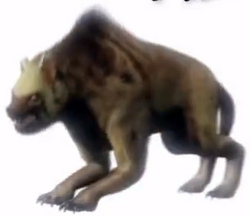| Nandi Bear | |||
|---|---|---|---|

| |||
| Naming | |||
| Others | Chemosit Kerit Koddoelo Gadett Khodumodumo | ||
| Binomen | N/A | ||
| Morphology | |||
| Body type | Mammalian | ||
| Average height | Bear-sized | ||
| Intelligence | |||
| Sentience | Sentient | ||
| Sapience | Non-Sapient | ||
| Aggressivity | Extreme | ||
| Ecology | |||
| Place of origin | Kenya | ||
| Habitat | Nandi and Kakamega forests | ||
| Diet | Carnivorous | ||
| Locomotion | Quadrupedal | ||
| Status | DD | ||
| Behind the Scenes | |||
| Universe | Real | ||
The Nandi Bear; a.k.a. Chemosit, and sometimes known by other names; is an exceedingly ferocious cryptid and a mysterious predator believed to inhabit the Nandi district of Kenya. Reportedly, it eats only the brains of its victims (a habit shared with other African cryptids, such as the mamlambo).
The physical appearance of this animal, as described across different sightings, is extremely varied, thus leading experts to believe that the "Nandi Bear" designation actually applies to more than one type of beast, with candidates including actual bears, ratels, hyenas, primates, and possibly prehistoric taxa such as chalicotheres or hyaenodonts.
Biology[]
The Nandi Bear is a ferocious beast, similar in size and physique to a bear, but with its shoulders higher than its hind-quarters, giving it resemblance to a large and powerful hyena. It has elongated forelimbs with huge claws. Some have also linked it to a monstrous baboon, and it has been alternatively described as a giant hyena with the head of a bear, or, more rarely, the other way around (i.e. a bear with the face of a hyena).
Proposed identities for this cryptid include: a real but extinct species of African bears (Agriotheriium africanum); a large relative of hyenas (Pachycrocuta brevirostris, which was a lion-sized active predator), or predatory baboons (Dinopithecus ingens or Theropithecus oswaldi); a surviving hyaenodont, such as the polar-bear-sized African Simbakubwa kutokaafrika; or even a surviving chalicothere (although these are currently thought to have been herbivores). Barring the hyaenodonts; which became extinct in the Miocene; all of these were present in Pleistocenic Africa, meaning any of them could conceivably have survived long enough to give rise to the Nandi Bear legend.
The Nandi Bear's famously ferocious behavior has led Bernard Heuvelmans to link it to a large melanistic ratel (a.k.a. honey badger) as well. Incidentally, Heuvelmans also noted that the "Nandi Bear" designation resulted from an artificial lumping of several distinct creatures reported from the same region, including the monstrous ratel, giant baboons (koddoelo), and giant forest hyenas (kerit or gadett). The name "chemosit", specifically, has been commonly applied to the creature that Heuvelmans deemed a melanistic ratel, but also to the giant hyenas.
For the past 60 years there have been almost no reports of this creature, leading many cryptozoologists to assume that it has since become extinct. Those who believe the Nandi Bear to be a chalicothere (and therefore a type of perissodactyl) often postulate the idea that the species may have died out during the great rinderpest epidemic of 1899: a disease that only affects ungulates.
In popular culture[]
The Nandi Bear is featured in C.T. Stoneham's short story "The Bear of the Nandi", published as part of his book, Killers and Their Prey (1933). It was also featured in Tarzan comics in March 1963, and in an episode of Destination Truth.
Notes[]
- The name Chemositia has been given to a genus of extinct Kenyan chalicotheres, acknowledging one of the possible identities of the Chemosit (a.k.a. Nandi Bear).
